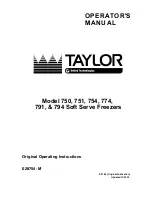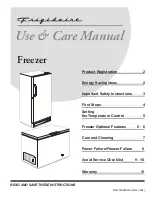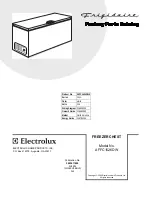
OM0299
P
AGE
8
OF
41
R
EV
1
D
ECEMBER
/2020
4.0 Usage Precautions
•
While the unit is operating, the door frame will become slightly warm. The embedded hot gas halo tube
provides latent heat to prevent condensation to from on the door frame.
•
Before samples are loaded into a freezer, make sure the unit has reached the set temperature. Samples should
be loaded into the freezer in batches. Each batch should be no more than 1/3 of the freezer capacity. This
process allows the freezer to pulldown the temperature in a reasonable time without damaging the
compressor.
•
The temperature display indicates the temperature where the temperature sensor is mounted inside the unit
chamber, which may vary from the temperature at the center of the freezer, but it will gradually reach the
actual temperature of the freezer over time.
•
Two access ports are available for testing in the back of the freezer. Thermocouple wires can go through the
port holes to reach the interior of the freezer for temperature mapping. The gap of the holes should be sealed
with insulation materials so that the interior temperature is not influenced by the ambient
temperature.
•
When cleaning the unit, mild and neutral detergent solution should be used. Never use a hard wire brush,
acid, gasoline, detergent powder, polished powder or hot water for cleaning. These tools and materials can
damage the paint and coating of the unit. Particularly, never use gasoline or a solution with volatile chemicals
to clean plastic or rubber parts.
•
After the freezer runs for some time, a layer of frost usually forms on the interior wall and inner doors. When
the frost gets too thick, th
e refrigeration effect can be impaired. Energy consumption will increase. If the
thickness reaches 3/16” (5 mm), please use the supplied scrapper to remove the frost.
•
Before removing the frost, temporarily transfer the stored samples to another freezer. This is so that the
temperature does not rise in the unit and damage the samples.
•
Behind the interior walls, there are many refrigeration tubes. Do not use a knife, an ice pick, or a screwdriver
to cut ice and frost. This may damage not only the liner but also the refrigeration tubes.
•
If the freezer is not in use for a long time, please turn off the power and switch off the backup battery. The
power cord should be unplugged.
•
Federal Communications Commission (FCC) Interference Statement
o
This equipment has been tested and found to comply with the limits for a Class B digital device,
pursuant to Part 15 of the FCC Rules.
o
These limits are designed to provide reasonable protection against harmful interference in a
residential installation. This equipment generates, uses and can radiate radio frequency energy and,
if not installed and used in accordance with the instructions, may cause harmful interference to radio
communications.
o
However, there is no guarantee that interference will not occur in a particular installation. If this
equipment does cause harmful interference to radio or television reception, which can be determined
by turning the equipment off and on, the user is encouraged to try to correct the interference by one
of the following measures:
-
Reorient or relocate the receiving antenna.
-
Increase the separation between the equipment and receiver.
-
Connect the equipment into an outlet on a circuit different from that to which the receiver
is connected.
-
Consult the dealer or an experienced radio/TV technician for help.
•
This device complies with Part 15 of the FCC Rules. Operation is subject to the following two condition:
1.
This device may not cause harmful interference
2.
This device must accept any interference received, including interference that may cause undesired
operation.









































